

Compaq ProLiant 5000 |
ContentsExecutive SummaryIntroduction Mindcraft's Certification Performance Analysis Test Procedures SUT Configuration Test Lab Glossary App1: Webstone Changes App2: O/S Configuration |
Executive Summary
This Certified Performance Report is for the Compaq ProLiant 5000 running the Windows NT Server 4.0 operating system and the Microsoft Internet Information Server 2.0. It covers one, two, and four processor configurations of the ProLiant 5000.
The WebStone 2.0.1 benchmark was used to test the system. The maximum number of connections per second attained for the system is shown in Figure 1 and the peak throughput in Mbits per second is shown in Figure 2. A table summarizing the peak performance follows Figure 2. The four processor HTML test results are not reported because the maximum network bandwidth was reached before the processors were fully utilized. The two processor HTML results were also limited by the test network bandwidth as evidenced by a 90% average CPU utilization on both processors at the peak connection rate.
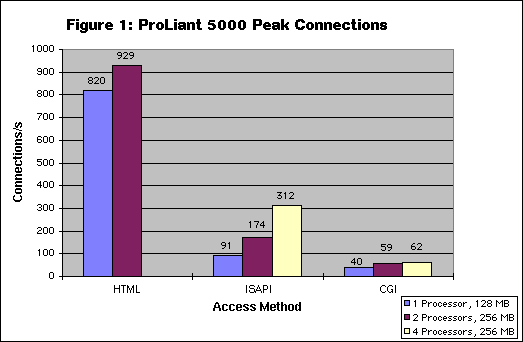
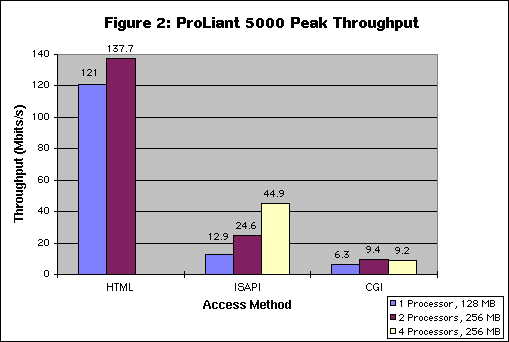
| Peak Performance Data Compaq ProLiant 5000 Windows NT Server 4.0 Microsoft Internet Information Server 2.0 WebStone 2.0.1 | ||||||||||||||
| Configuration | Connections/s | Throughput, Mbits/s | ||||||||||||
| 1 processor, 128 MB |
|
| ||||||||||||
| 2 processors, 256 MB |
|
| ||||||||||||
| 4 processors, 256 MB |
|
| ||||||||||||
Introduction
This Performance Report was commissioned by Compaq Computer Corporation to demonstrate the performance of their ProLiant 5000 server and to allow readers to compare the performance of the ProLiant 5000 with that of servers from other vendors. Two 100Base-TX network interfaces were used on the server. In addition, the WebStone 2.0.1 run rules were extended to include runs with up to 600 client threads. Minor changes were made to the WebStone scripts to allow us to run client systems against two different network interfaces and to accommodate the command syntax of the webclient program on the Windows NT client systems. WebStone code changes are given in Appendix 1.
Mindcraft's Certification
Mindcraft, Inc. conducted the performance tests described in this report between November 15 and 22, 1996 at our laboratory in Palo Alto, California. Mindcraft used the WebStone 2.0.1 test suite to measure performance.
Mindcraft certifies that the results reported herein fairly represent the performance of Compaq's ProLiant 5000 computer running Microsoft's Internet Information Server 2.0 under Microsoft's Windows NT Server 4.0 operating system as measured by the WebStone 2.0.1 test suite. Our test results should be reproducible by others who use the same test lab configuration as well as the computer and software configurations and modifications documented in this report.
Performance Analysis
This analysis is based on the complete WebStone benchmark results for the ProLiant 5000.
The WebStone 2.0.1 benchmark stresses a system's networking ability in addition to other aspects of server performance. The best way to see if there is unused capacity on a server computer running WebStone is to look at the CPU utilization. It was 100% for the one-processor configuration tests when the peak performance was reached. Since Ethernets transmit between 50% and 70% of their rated bandwidth, the 121 Mbits/second throughput for the HTML test was near the upper limit, but did not reach the limit shown by the two-processor tests. So the one-processor tests did fully utilize the system.
For the two-processor configuration, both CPUs averaged 90% utilization during the HTML test. The 137.7 Mbits/second maximum HTML throughput represents 68.85% of the rated bandwidth for each of the two networks used to test the ProLiant 5000. This indicates that the networks were carrying as much as could be expected. The limiting performance factor was the bandwidth of the two 100 Mbit Ethernets, not the ProLiant 5000, because the CPUs were not fully utilized. Both CPUs were 100% utilized for the ISAPI and CGI tests and the networks were not near their bandwidth limits, so the results show the full performance of the ProLiant 5000 for these tests.
We did not publish the HTML test results of a four-processor ProLiant 5000 because we were able to saturate the lab networks with a two-processor server and, therefore, would not see better performance from a four-processor server. The ISAPI and CGI tests ran at 100% CPU utilization and did not approach the maximum network bandwidth. Therefore, these tests of the four-processor configuration show the system's full performance.
Due to network bandwidth limits, the HTML tests did not show the full benefits of adding more processors. The ISAPI tests show the benefits of adding more processors; the results scale with of the number of CPUs. The CGI results do not show the same level of performance scaling based on the number of processors as the ISAPI results. We believe that this lack of scaling is caused by the additional CPU overhead needed to create and launch a new process for every CGI connection.
Figures 3, 4, and 5 below show IIS's network throughput capability on a ProLiant 5000. These figures show reasonably flat throughput over the range of clients tested and for all access methods.
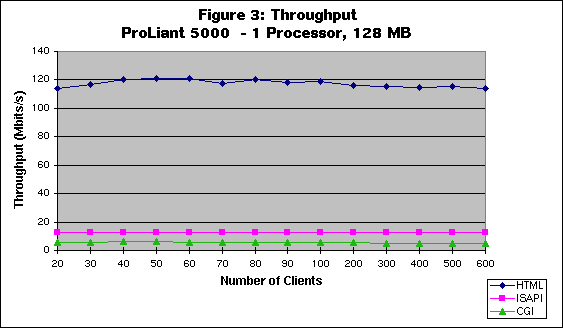
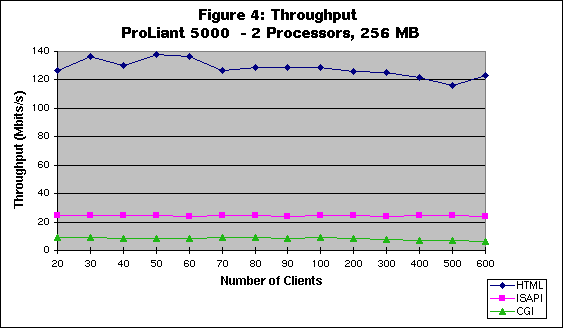
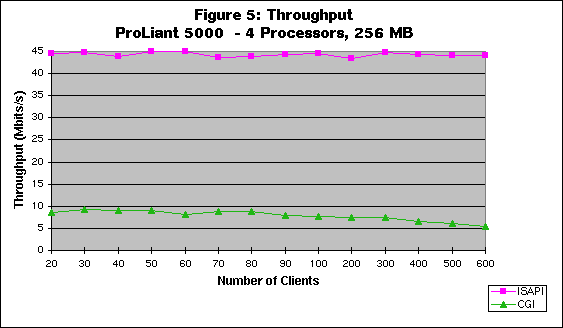
The WebStone load that a server computer can support depends on four primary factors:
- The bandwidth of the networks available;
- The ability of the operating system to utilize the available network bandwidth;
- The ability of the operating system to maximize the CPU time available to the Web server; and
- The rate at which the Web server can process requests
There is a strong correlation between the number of connections/second a server can provide and the throughput (in Mbits/second) it exhibits. This can be seen by comparing the connections/second per client in Figures 6, 7 and 8 below with the throughput in Figures 3, 4, and 5. The connection rate is relatively flat from 20 to 600 clients for IIS on a ProLiant 5000.
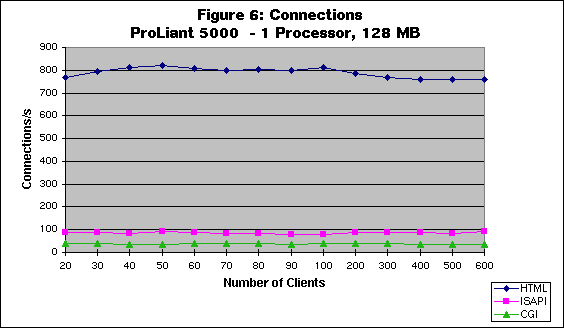
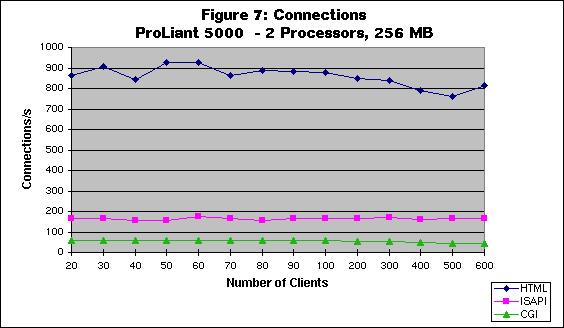
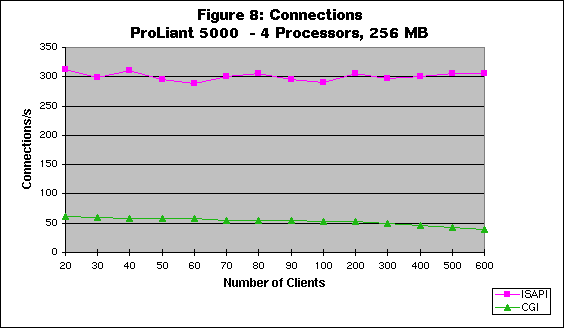
Test Procedures and Test Suite Configuration
Test Procedures
Mindcraft followed the standard WebStone 2.0.1 run rules with the following extensions:
- In addition to the standard run from 10 to 100 clients, we also ran tests for 200 to 600 clients in order to show the capabilities of these systems.
- We modified the runbench and webmaster.c files to support clients running on Windows NT systems. Code changes are shown in Appendix 1.
The following basic set of procedures was used for performing these tests:
- The HTTP server was started automatically at boot time.
- For the HTML runs, the server log files were deleted after each run from 10 to 100 clients and after each run from 200 to 600 clients.
- All test runs were done with the server console idle (no user logged in).
Test Suite Configuration
Testing was controlled from a Ross Technology SPARCplug system running Solaris 2.5.1 and a webmaster binary compiled on that system using gcc. The webclient program was compiled on a Windows NT 4.0 Server system using Microsoft Visual C++ version 4.2. Minor changes were made to the WebStone scripts to allow us to run client systems against two different network interfaces and to accommodate the different command syntax of the webclient program on the Windows NT client systems. WebStone code changes are given in Appendix 1.
Test Data
The data files used for the static HTML testing were the default "Silicon Surf" fileset, distributed as filelist.standard with the WebStone 2.0.1 benchmark.
This static HTML fileset was designed to represent a real-world server load. It was created based on analysis of the access logs of Silicon Graphics, Inc.'s external Web site, http://www.sgi.com. Netscape's analysis of logs from other commercial sites indicated that Silicon Surf access patterns were fairly typical for the Web when they were designed.
The Silicon Surf model targets the following characteristics:
- 93% of accessed files are smaller than 30 KB.
- Average accessed file is roughly 7 KB.
Configuration of the System Tested
| Web Server Software | Vendor: Microsoft Corp. HTTP Software: Internet Information Server 2.0 Number of threads: Default Server Cache: Default Log Mode: Common Tuning:The server ran error logging and access logging. DNS reverse name lookups were disabled to keep DNS server performance from affecting the tests of Web server performance. We ran a single Web server that served both network interfaces. |
| Computer System |
Vendor: Compaq Computer Corporation Model: ProLiant 5000 Processor: 200 MHz Intel Pentium Pro Number of Processors: 4 (one- and two-processor configurations also tested) Memory: 256 MB EDO RAM (128 MB used for 1-processor tests) Disk Subsystem: 1- Compaq 2 GB drive Disk Controller: 1 - embedded Fast-Wide SCSI-2 Controller Network Controllers: 1 - Compaq NetFlex III PCI 10/100Base-TX 1 - Compaq Netelligent PCI 10/100Base-TX Tuning: The system's run-time configuration file (boot.ini) was changed so that only one CPU and 128 MB of RAM would be used for single-processor testing, using a uniprocessor kernel. Different boot.ini lines caused a multiprocessor kernel and 256 MB of RAM to be used for two and four processor testing. |
| Operating System | Microsoft Windows NT 4.0 Server with the tcpip.sys file from the prospective Service Pack 2 installed. Other system configuration parameters used are listed in Appendix 2. |
| Network | Type and Speed: 100Base-TX Ethernet Number of Nets: 2 Additional Hardware: 1 Compaq Netelligent 100Base-TX hub and 1 Linksys 100Base-TX Hub |
Test Lab Configuration
In order to cause the Microsoft Internet Information Server to use all
available CPU cycles on the server computer system, we used four WebStone
client systems. A fifth system served as the Webmaster, controlling the
WebStone driver. The test lab network configuration used for this work
is shown below:
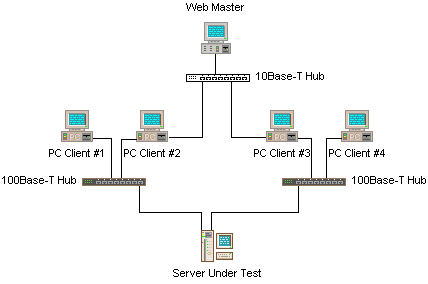
| WebStone Client Computer Systems |
Vendor: HD Computer Company Model: Victoria Processor: 200 MHz Pentium Pro on an Intel Venus motherboard Number of Processors: 1 Memory: 64 MB EDO RAM Disk Subsystem: One 2 GB IDE Disk Disk Controllers: Built-in EIDE Network Controllers: 3Com 3C905 PCI 10/100Base-TX Interface Number of Clients: Four (two per net) |
| Operating System and Compiler |
Operating System: Microsoft Windows NT 4.0 Server with the tcpip.sys
file from prospective Service Pack 2 installed Compiler: Microsoft Visual C++ Version 4.2 |
The tests described in this report were performed on isolated LANs that were quiescent except for the test traffic.
Glossary
- Clients
- Number of processes or threads simultaneously requesting Web services from the server.
- Connections per second
- Average rate of creation and destruction of client/server connections.
- Errors per second
- Error rate for this run.
- Latency
- Average client wait for data to be returned.
- Throughput
- Average net data transfer rate, in megabits per second.
Appendix 1: Changes to WebStone 2.0.1 Source
The following output from diff illustrates our changes:
Changes to bin/runbench: Comment out rcp and rsh commands directed at the NT hosts, and change the generated webclient configuration file to specify the server name. This uses a facility that's built into the software, but isn't used by the standard version of the WebStone run scripts.
17c17
< [ -n "$DEBUG" ] && set +x
> [ -n "$DEBUG" ] && set -x
87,90c87,90
< for i in $CLIENTS
< do
< $RCP $WEBSTONEROOT/bin/webclient $i:$TMPDIR #/usr/local/bin
< done
> #NT: for i in $CLIENTS
> #NT: do
> #NT: $RCP $WEBSTONEROOT/bin/webclient $i:$TMPDIR #/usr/local/bin
> #NT: done
101c101
< TIMESTAMP=`date +"%y%m%d_11/06/96M"`
> TIMESTAMP=`date +"%y%m%d_%H%M"`
107,110c107,110
< for client in $CLIENTS
< do
< $RSH $client "rm /tmp/webstone-debug*" > /dev/null 2>&1
< done
> #NT: for client in $CLIENTS
> #NT: do
> #NT: $RSH $client "rm /tmp/webstone-debug*" > /dev/null 2>&1
> #NT: done
119a120,121
> CLIENTNET=`expr $i : "(.*)\..*"`
> SERVERNAME=$[Macro error: j6- dagger]]
.$[Macro error: j6- dagger]]
122,123c124,125
< echo "$i $CLIENTACCOUNT $CLIENTPASSWORD `expr $CLIENTSPERHOST + 1`"
< >> $LOGDIR/config
> echo "$i $CLIENTACCOUNT $CLIENTPASSWORD `expr $CLIENTSPERHOST + 1`
> $SERVERNAME" >> $LOGDIR/config
126c128
< echo "$i $CLIENTACCOUNT $CLIENTPASSWORD $CLIENTSPERHOST"
---
> echo "$i $CLIENTACCOUNT $CLIENTPASSWORD $CLIENTSPERHOST $SERVERNAME"
135,140c137,142
< for i in $CLIENTS localhost
< do
< $RSH $i "rm -f $TMPDIR/config $TMPDIR/`basename $FILELIST`"
< $RCP $LOGDIR/config $i:$TMPDIR/config
< $RCP $LOGDIR/`basename $FILELIST` $i:$TMPDIR/filelist
< done
> #NT: for i in $CLIENTS localhost
> #NT: do
> #NT: $RSH $i "rm -f $TMPDIR/config $TMPDIR/`basename $FILELIST`"
> #NT: $RCP $LOGDIR/config $i:$TMPDIR/config
> #NT: $RCP $LOGDIR/`basename $FILELIST` $i:$TMPDIR/filelist
> #NT: done
145,149c147,151
< $RSH $SERVER "$SERVERINFO" > $LOGDIR/hardware.$SERVER 2>&1
< for i in $CLIENTS
< do
< $RSH $i "$CLIENTINFO" > $LOGDIR/hardware.$i 2>&1
< done
> #NT: $RSH $SERVER "$SERVERINFO" > $LOGDIR/hardware.$SERVER 2>&1
> #NT: for i in $CLIENTS
> #NT: do
> #NT: $RSH $i "$CLIENTINFO" > $LOGDIR/hardware.$i 2>&1
> #NT: done
151,156c153,156
< set -x
< for i in $OSTUNINGFILES $WEBSERVERTUNINGFILES
< do
< $RCP $SERVER:$i $LOGDIR
< done
< set +x
> #NT: for i in $OSTUNINGFILES $WEBSERVERTUNINGFILES
> #NT: do
> #NT: $RCP $SERVER:$i $LOGDIR
> #NT: done
162,164c162,166
< CMD="$WEBSTONEROOT/bin/webmaster -v -u $TMPDIR/filelist"
< CMD=$CMD" -f $TMPDIR/config -t $TIMEPERRUN"
< [ -n "$SERVER" ] && CMD=$CMD" -w $SERVER"
> #GREG: bug fix: changed $TMPDIR below to $LOGDIR
> CMD="$WEBSTONEROOT/bin/webmaster -v -W -u $LOGDIR/filelist"
> #GREG: bug fix: changed $TMPDIR below to $LOGDIR
> CMD=$CMD" -f $LOGDIR/config -t $TIMEPERRUN"
> #GREG: [ -n "$SERVER" ] && CMD=$CMD" -w $SERVER"
Changes to sysdep.h: Emit an NT-style command line and to fix a C
portability problem.
48c48
< #error NT gettimeofday() doesn't support USE_TIMEZONE (yet)
> #error NT gettimeofday() does not support USE_TIMEZONE (yet)
87a88
> #ifdef SOLARIS_CLIENT
88a90,92
> #else
> #define PROGPATH "D:\webstone2.0\webclient.exe" /* "/usr/local/bin/webclient" */
> #endif /* SOLARIS_CLIENT */
Changes to webmaster.c: Emit an NT-style command line, and fix a bug that
shows up on Solaris.
539a540
> #ifdef SOLARIS_CLIENT
550a552
> #endif /* SOLARIS_CLIENT */
586a589
> #ifdef SOLARIS_CLIENT
588a592,594
> #else
> strcat(commandline, " -u d:\WebStone2.0\filelist");
> #endif /* SOLARIS_CLIENT */
1395a1402
>
1398a1406,1408
> size_t count;
> char **sptr, **dptr;
> struct in_addr *iptr;
1406,1407d1415
< dest->h_addr_list = src->h_addr_list;
< }
1408a1417,1446
> /*
> * ADDED: by Greg Burrell of Mindcraft Inc. 10/22/96
> * PROBLEM: we can't just do the assignment:
> *
> * dest->h_addr_list = src->h_addr_list
> *
> * because those are just pointers and the memory pointed to
> * may get overwritten during the next gethostbyname() call.
> * In fact, that happens on Solaris 2.5
> *
> * FIX: Make a copy of the h_addr_list of a hostent structure.
> * h_addr_list is really an array of pointers. Each pointer
> * points to a structure of type in_addr. So, we allocate space
> * for the structures and then allocate space for the array of
> * pointers. Then we fill in the structures and set up the array
> * of pointers.
> */
> for(count = 0, sptr = src->h_addr_list; *sptr != NULL; sptr++, count++);
> if ((dest->h_addr_list = malloc(count + 1)) == NULL)
> return 0;
> if ((iptr = malloc(count * sizeof(struct in_addr))) == NULL)
> return 0;
> for (sptr = src->h_addr_list, dptr = dest->h_addr_list;
> *sptr != NULL; sptr++, dptr++, iptr++) [Macro error: j6- dagger]]
> *dptr = NULL;
> return 1;
> }
Appendix 2: Operating System Configuration
System Identification:
From the winmsd program:Microsoft® Windows NT® Version 4.0 (Build 1381)
tcpip.sys from Microsoft's prospective Service Pack 2 for Windows NT was installed.
Run Time Parameters
From Registry Editor:
HKEY_LOCAL_MACHINE SYSTEM
CurrentControlSet
Services
InetInfo
Parameters
ListenBacklog: 1024
HKEY_LOCAL_MACHINE SYSTEM
CurrentControlSet
Services
Tcpip
Parameters
TcpTimedWaitDelay: 1
HKEY_LOCAL_MACHINE SYSTEM
CurrentControlSet
Services
cpqnf30
Parameters
MaxReceives: 500
It was probably not necessary to change the TcpTimedWait Delay parameter from its default value. We have done some trial WebStone runs with this parameter clear, and the results are within the range of run-to-run variability we observed with the parameter set.
Active Services:
Microsoft Internet Information Server https-192.168.1.9
Microsoft Internet Information Server https-192.168.2.9
Alerter
Event Log
License Logging Service
RPC Service
Server
Spooler
All other services were disabled.
